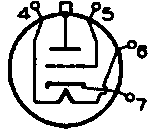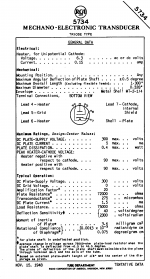
5734
|
|
|||||||||||||||||||||||||||||||||
|
Hits: 11099 Replies: 3
Vacuum tube phono cartridge
|
|
|
Emilio Ciardiello
05.Nov.09 |
1
According to Sibley in ‘Tube Lore’, around the early fifties RCA promoted its 5734 electro-mechanic transducer triode as building block for non-conventional phonographic pick-up cartridges. Regards, Emilio |
|
Joe Sousa
06.Nov.09 |
2
Hello Emilio, This is great! I had heard about the existence of this cartridge, but had never seen one, and some people said it was never made. I imagine that this single triode could have been wired as a push-pull driver/phase splitter in a double pentode arrangement. The tube complement for a phonograph sold for the US market might have been might have been 5734, 35C5, 35C5, 35W4. One possible issue with the active cathode as phase splitter, would be hum pickup from the heater. I had tried to find applications for this tube in the past, and came across two applications in the field of biology. Muscle tension was measured In both applications: -------------------------- TENSION CHANGES DURING AND AFTER STRETCH IN The following excerpt came from page 239 at http://www.ncbi.nlm.nih.gov/pmc/articles/PMC1331100/ "Tension transducer. Tensions were recorded with an RCA 5734 tube having an -------------------------- CONTRACTION KINETICS OF THE FAST MUSCLES The following excerpt came from page 784 at http://jeb.biologists.org/cgi/reprint/59/3/781 "The tergocoxal muscle was exposed, the mesothoracic leg was cut distal -------------------------- These papers seem to be in the public domain. I left the question open for you, in case someone finds another cartridge example. Regards, -Joe |
|
Emilio Ciardiello
11.Nov.09 |
3
First of all, my thanks to Joe Sousa for the unvalued role he played in looking for old technical materials and to his many friends which gave their contribution. Here the synthetic overview of what has been found.
The tube is a twin diode, with a fixed common cathode and two plates, one on each side of the cathode. The plates are elastically mounted so that they can move when the base of the tube is subjected to accelerations. The tube has been coded here as Ramberg_tube. Regards, Emilio |
|
Joe Sousa
13.Nov.09 |
4
Thank you Emilio for the kind words, and for the excellent overview you just presented. The Ramberg article can be read by clicking these thumbnails: These scans were about 50% larger in pdf format; I think because of the mixed gif/jpg content, so I kept the scans in their original image formats. Note that the cover has a special note at the top right in a black box, indicating that this is the "Radio-electronic Engineering Edition". This version of the magazine includes the xxA pages, which were edited for professional engineers. The remaining content is for a general audience. The "regular" issue does not include these special pages in yellow paper stock. The special section increased the page count about 10-20%. I have both issues. Initially, this led to some confusion. Regards, -Joe |
End of forum contributions about this tube
| Data Compliance | More Information |











